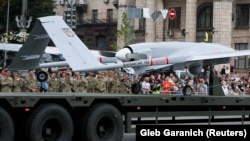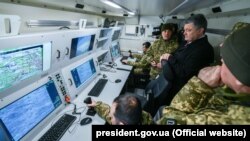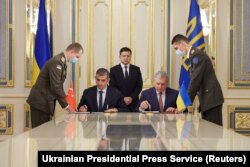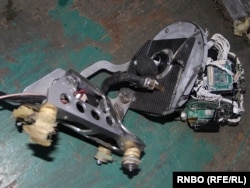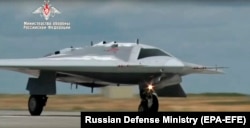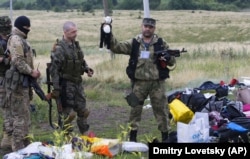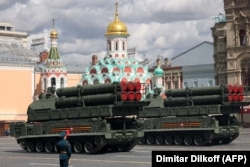After over seven years of nonstop warfare, Ukrainian and other military experts believe Turkey’s hi-tech unmanned aerial vehicles could give Kyiv a tactical advantage in its conflict with Moscow-backed separatists in Ukraine’s eastern Donbas region, a war that has cost over 13,000 lives and displaced more than a million people since 2014.
Despite condemnations from France and Germany, the interviewed experts believe these unmanned aerial vehicles (UAVs) could deter the separatist fighters, who rely on Russian arms supplies, from furthering the violence.
“If they’ll use them massively, this will change the conflict’s paradigm,” Israeli security expert Sergei Migdal predicted, speaking of the Ukrainian military.
Separatist forces would find themselves constantly on the defensive, Migdal continued, while other specialists noted that Russia, a mediator in the conflict, would find it “complicated” to equip these fighters to respond.
No clear response could be seen in Ukraine’s video footage of the Bayraktar (Standard-Bearer) TB2 long-range, unmanned aerial vehicle (UAV) destroying a separatist howitzer on October 26.
The drone, manufactured by the private Turkish military supplier Baykar, can carry up to four missiles a maximum of 150 kilometers (93 miles) and remain airborne for 12-24 hours.
Used successfully in Syria and Libya against Russian air defense systems, the Bayraktar TB2 most recently has been credited with facilitating Azerbaijan’s victory in its 2020 Nagorno-Karabakh war against Armenia and Armenia-backed separatists.
That conflict demonstrated Russian-made air defense systems’ difficulties in countering the Turkish drones, noted a March 2021 research paper for the International Institute for Strategic Studies, a global think tank.
Kyiv has duly taken note. Since 2019, it has purchased 12 Baykar drones and plans to acquire another 48, according to Ivan Yakubets, a former commander of Ukraine’s Aeromobile Forces.
That stockpile could expand still further. A Ukrainian factory to manufacture Baykar UAVs, including for export, will be ready “within months,” Ukraine’s ambassador to Turkey, Vasyl Bodnar, told RFE/RL’s Ukrainian Service on October 31. Ukraine will also host Baykar training and storage facilities.
Under a separate, $7 million deal, Ukraine’s aeronautical engine company Motor Sich recently agreed to provide Baykar with 30 turboprop engines to use in its Akinci strike drones. These, too, could be added to the Ukrainian drone fleet, Yakubets conjectured.
Each Baykar complex of four to six drones can be configured individually, thereby providing “a constantly active field” for reconnaissance or strikes along the line of contact, explained Sergei Zgurets, head of Kyiv’s private Defense Express consulting firm.
Under a 2020 agreement, only the Organization for Security and Cooperation in Europe’s ceasefire monitoring mission is permitted to use drones, strictly for reconnaissance, in the conflict zone, however.
But Donbas separatists also possess drones. In a report funded by the European Union and Germany, Conflict Armament Research, a London-based group that investigates and tracks international weapons supplies, stated this month that Ukrainian forces between 2018 and 2020 retrieved six types of Russian military UAVs and one civilian UAV from separatist-controlled areas of Donbas.
The fighters also have radar reconnaissance to detect enemy drones, although this technology is “inconsequential” without an air defense battery to down the vehicles, Yakubets noted.
Yet Ukrainian experts believe that, in any battle with Russian-made drones, Turkish UAVs would have a clear tactical advantage.
Separatist fighters’ Russian-made drones are “obsolete,” scoffed Mikhail Samus, deputy director of the Center for Army Research, Conversion and Disarmament, a Kyiv think tank. He described them as explosives strapped to ordinary quadrocopters (a mini-drone with four propellers) and likened their precision to that of manually thrown grenades during World War I.
Russia’s own drone technology, however, could not easily be called obsolete.
Its medium-range Inokoodets (Pacer), which goes into production this month, is seen as roughly compatible to the Bayraktar TB2. Another priority project, the Sukhoi S-70 Okhotnik (Hunter)-B, slotted for release in 2024, can act as a “flying wing stealth bomber without a pilot” or, allegedly, human guidance, according to a July 2021 overview of Russian drones in The National Interest.
Nonetheless, Samus reasons that Russian President Vladimir Putin’s November 2 call for the Russian military to make greater use of artificial intelligence “and the latest scientific and technological advances” to enhance Russia’s drone arsenal suggests that Putin senses the need for a UAV that “could compete with the Ukrainian armed forces.”
Based on Putin’s figures, however, Russia’s “more than 2,000” working drones would give it a vast numerical advantage over Ukraine.
That does not concern Yakubets.
“Everything will depend on the intensity of the armed conflict,” he said. “If the armed conflict will be like it is today, then 48 [drones] will be enough, but if the conflict heats up with the massive use of mechanized tank troops, artillery, like it was in 2014-2015, then it’s possible there won’t be enough.”
Like the Ukrainian government, Ukrainian military specialists tend to dismiss recent U.S. media reports of a marked accumulation of Russian troops and military equipment near Ukraine’s eastern border as inaccurate or disinformation.
The experts also doubt that Russia would deploy any air defense systems to help separatist fighters counter Ukraine’s Turkish drones.
In 2014, Donbas fighters used a Russian surface-to-air Buk system to shoot down Malaysia Airlines Flight MH17, a Boeing 777 which they apparently mistook for a Ukrainian military plane, according to international investigators. All 298 people on board died.
Since fighting began in Donbas in 2014, however, Russia has denied that its military plays any role in the fighting, which it describes as a “domestic Ukrainian problem.”
Using an air defense system such as Russia’s Buk or a radio-electronic communications system to down the Bayraktars would mean “revealing yourself, and it will be a lot more difficult to say '‘But we’re not there,’” noted Mikola Beleskov, an analyst at the Ukrainian government’s National Institute for Strategic Studies.
Technical challenges also exist. “It’s one thing to pound on a Boeing, which weighs 200 tons,” with a surface-to-air system, commented Migdal. “It’s another matter with a Bayraktar, which has a small section on radar, almost like a bird,” he said.
For now, Moscow appears to believe that the best form of defense against Ukraine’s Turkish drones is verbal.
On October 27, Putin spokesman Dmitry Peskov warned that deliveries of these drones to Ukrainian forces “can destabilize the situation in Donbas.”
Russian Foreign Minister Sergei Lavrov has charged that Ukraine is attempting “to drag” Russia into the conflict, while Russia’s United Nations Ambassador Vasily Nebenzia has denounced Ukraine’s October use of the Bayraktar as a “dangerous game.”
Reinforcing that criticism, Russian Foreign Ministry spokeswoman Maria Zakharova claimed on November 6 that an OSCE patrol came within the “zone of attack” of a Ukrainian military drone -- a claim at odds with the actual OSCE report, which did not identify the provenance of the mini-drone.
Such denunciations, however, are doing little to dissuade Ukraine. President Volodymyr Zelenskiy maintains that Ukraine’s use of the Bayraktar TB2 was not “an offensive,” but a response to separatist artillery.
Yakubets described France and Germany’s concerns as “crocodile tears,” while analyst Beleskov dismissed Lavrov’s condemnation as “absolutely laughable.”
-With additional reporting from TASS




